46070_TTLX_L nzIM.qxd 1/28/11 9:43 AM Page 1
�
46070_TTLX_L nzIM.qxd 1/28/11 9:43 AM Page 2
World Headquarters
Jones & Bartlett
Learning
40 Tall Pine Drive
Sudbury, MA 01776
978-443-5000
info@jblearning.com
www.jblearning.com
Jones & Bartlett
Learning Canada
6339 Ormindale Way
Mississauga, Ontario
L5V 1J2
Canada
Jones & Bartlett
Learning International
Barb House, Barb Mews
London W6 7PA
United Kingdom
Jones & Bartlett Learning books and products are available through most
bookstores and online booksellers. To contact Jones & Bartlett Learning directly,
call 800-832-0034, fax 978-443-8000, or visit our website, www.jblearning.com.
Substantial discounts on bulk quantities of Jones & Bartlett Learning
publications are available to corporations, professional associations, and other
qualified organizations. For details and specific discount information, contact
the special sales department at Jones & Bartlett Learning via the above contact
information or send an email to specialsales@jblearning.com.
Copyright © 2012 by Jones & Bartlett Learning, LLC
All rights reserved. No part of the material protected by this copyright may be
reproduced or utilized in any form, electronic or mechanical, including
photocopying, recording, or by any information storage and retrieval system,
without written permission from the copyright owner.
Production Credits
Publisher: Cathleen Sether
Senior Acquisitions Editor: Timothy Anderson
Senior Editorial Assistant: Stephanie Sguigna
Production Director: Amy Rose
Senior Marketing Manager: Andrea DeFronzo
Composition: Northeast Compositors, Inc.
Title Page Design: Kristin E. Parker
6048
15 14 13 12 11 10 9 8 7 6 5 4 3 2 1
�
✐
✐
“46070˙PREF˙LinzIM” — 2011/1/28 — 13:30 — page iii — #1
✐
✐
Preface
T he aim of this manual is to provide assistance to instructors using
my book An Introduction to Formal Languages and Automata, Fifth
Edition. Since this text was organized on the principle of learning
by problem solving, much of my advice relates to the exercises at
the end of each section.
It is my contention that this abstract and often difficult subject matter
can be made interesting and enjoyable to the average undergraduate stu-
dent, if mathematical formalism is downplayed and problem solving is made
the focus. This means that students learn the material and strengthen their
mathematical skills primarily by doing problems. Now this may seem rather
obvious; all textbooks contain exercises that are routinely assigned to test
and improve the students’ understanding, but what I have in mind goes a
little deeper. I consider exercises not just a supplement to the lectures, but
that to a large extent, the lectures should be a preparation for the exercises.
This implies that one needs to emphasize those issues that will help the stu-
dent to solve challenging problems, with the basic ideas presented as simply
iii
✐
✐
✐
✐
�
✐
✐
“46070˙PREF˙LinzIM” — 2011/1/28 — 13:30 — page iv — #2
✐
✐
iv
Preface
as possible with many illustrative examples. Lengthy proofs, unnecessary
detail, or excessive mathematical rigor have no place in this approach. This
is not to say that correct arguments are irrelevant, but rather that they
should be made in connection with specific, concrete examples. Therefore,
homework has to be tightly integrated into the lectures and each exercise
should have a specific pedagogical purpose. Assignments need to be com-
posed as carefully and thoughtfully as the lectures. This is a difficult task,
but in my experience, the success of a course depends critically on how well
this is done.
There are several types of exercises, each with a particular purpose and
flavor. Some of them are straightforward drill exercises. Any student with
a basic understanding should be able to handle them. They are not always
very interesting, but they test the student’s grasp of the material, uncover
possible misunderstandings, and give everyone the satisfaction of being able
to do something.
A second type of exercise in the manual, I call “fill-in-the-details.” These
are usually omitted parts of proofs or examples whose broad outlines are
sketched in the text. Most of them are not overly difficult since all the
non-obvious points have been spelled out. For mathematically well-trained
students these exercises tend to be simple, but for those not in this cat-
egory (e.g., many computer science undergraduates) they may be a little
more difficult and are likely to be unpopular. They are useful primarily in
sharpening mathematical reasoning and formalizing skills.
The prevalent and most satisfying type of exercise involves both an
understanding of the material and an ability to carry it a step further.
These exercises are a little like puzzles whose solution involves inventiveness,
ranging from the fairly easy to the very challenging. Some of the more
difficult ones require tricks that are not easy to discover, so an occasional
hint may be in order. I have identified some of the harder problems with a
star, but this classification is highly subjective and may not be shared by
others. The best way to judge the difficulty of any problem is to look at
the discussion of the solution.
Finally, there are some exercises that take the student beyond the scope
of this course, to do some additional reading or implement a method on the
computer. These are normally quite time consuming and are suitable only
for extra-credit assignments. These exercises are identified by a double star.
For the actual solutions, I have done what I think is most helpful. When
a problem has a simple and concise answer, I give it. But there are many
cases where the solution is lengthy and uninformative.
I often omit the
details on these, because I think it is easier to make up one’s own answer
than to check someone else’s.
In difficult problems I outline a possible
approach, giving varying degrees of detail that I see necessary for following
✐
✐
✐
✐
�
✐
✐
“46070˙PREF˙LinzIM” — 2011/1/28 — 13:30 — page v — #3
✐
✐
Preface
v
the argument. There are also some quite general and open-ended problems
where no particular answer can be given. In these instances, I simply tell
you why I think that such an exercise is useful.
Peter Linz
✐
✐
✐
✐
�
✐
✐
“46070˙PREF˙LinzIM” — 2011/1/28 — 13:30 — page vi — #4
✐
✐
✐
✐
✐
✐
�
✐
✐
“46070˙TOCX˙LinzIM” — 2011/1/28 — 13:31 — page vii — #1
✐
✐
Contents
1
Introduction to the Theory of Computation
1.1 Mathematical Preliminaries and Notation . . . . . . . . . .
Three Basic Concepts . . . . . . . . . . . . . . . . . . . . .
1.2
1.3
Some Applications . . . . . . . . . . . . . . . . . . . . . . .
1
1
2
4
2 Finite Automata
2.1
2.2
2.3
2.4
Deterministic Finite Accepters
. . . . . . . . . . . . . . . .
Nondeterministic Finite Accepters . . . . . . . . . . . . . .
Equivalence of Deterministic and Nondeterministic Finite
Accepters . . . . . . . . . . . . . . . . . . . . . . . . . . . .
9
Reduction of the Number of States in Finite Automata . . 11
5
5
8
3 Regular Languages and Grammars
11
Regular Expressions . . . . . . . . . . . . . . . . . . . . . . 11
Connection Between Regular Expressions and Regular
Languages . . . . . . . . . . . . . . . . . . . . . . . . . . . . 14
Regular Grammars . . . . . . . . . . . . . . . . . . . . . . . 16
3.1
3.2
3.3
4 Properties of Regular Languages
Closure Properties of Regular Languages
Elementary Questions about Regular Languages
Identifying Nonregular Languages
17
. . . . . . . . . . 17
. . . . . . 21
. . . . . . . . . . . . . . 22
4.1
4.2
4.3
vii
✐
✐
✐
✐
�
✐
✐
“46070˙TOCX˙LinzIM” — 2011/1/28 — 13:31 — page viii — #2
✐
✐
viii
Contents
5 Context-Free Languages
25
Context-Free Grammars . . . . . . . . . . . . . . . . . . . . 25
Parsing and Ambiguity . . . . . . . . . . . . . . . . . . . . 28
Context-Free Grammars and Programming Languages . . . 29
5.1
5.2
5.3
6 Simplification of Context-Free Grammars and
Normal Forms
6.1 Methods for Transforming Grammars
6.2
6.3
29
. . . . . . . . . . . . 30
Two Important Normal Forms
. . . . . . . . . . . . . . . . 32
A Membership Algorithm for Context-Free Grammars . . . 33
7 Pushdown Automata
33
Nondeterministic Pushdown Automata . . . . . . . . . . . . 33
Pushdown Automata and Context-Free Languages . . . . . 36
Deterministic Pushdown Automata and Deterministic
Context-Free Languages . . . . . . . . . . . . . . . . . . . . 38
Grammars for Deterministic Context-Free Languages
. . . 39
7.1
7.2
7.3
7.4
8 Properties of Context-Free Languages
Two Pumping Lemmas
Closure Properties and Decision Algorithms for Context-
Free Languages . . . . . . . . . . . . . . . . . . . . . . . . . 43
40
. . . . . . . . . . . . . . . . . . . . 40
8.1
8.2
9 Turing Machines
45
. . . . . . . . . . . . . . . . 45
The Standard Turing Machine
Combining Turing Machines for Complicated Tasks
. . . . 47
Turing’s Thesis . . . . . . . . . . . . . . . . . . . . . . . . . 47
9.1
9.2
9.3
10 Other Models of Turing Machines
47
10.1 Minor Variations on the Turing Machine Theme . . . . . . 47
10.2 Turing Machines with More Complex Storage . . . . . . . . 48
10.3 Nondeterministic Turing Machines . . . . . . . . . . . . . . 50
10.4 A Universal Turing Machine
. . . . . . . . . . . . . . . . . 50
10.5 Linear Bounded Automata . . . . . . . . . . . . . . . . . . 50
51
11 A Hierarchy of Formal Languages and Automata
11.1 Recursive and Recursively Enumerable Languages
. . . . . 51
11.2 Unrestricted Grammars . . . . . . . . . . . . . . . . . . . . 53
11.3 Context-Sensitive Grammars and Languages
. . . . . . . . 54
11.4 The Chomsky Hierarchy . . . . . . . . . . . . . . . . . . . . 55
✐
✐
✐
✐
�
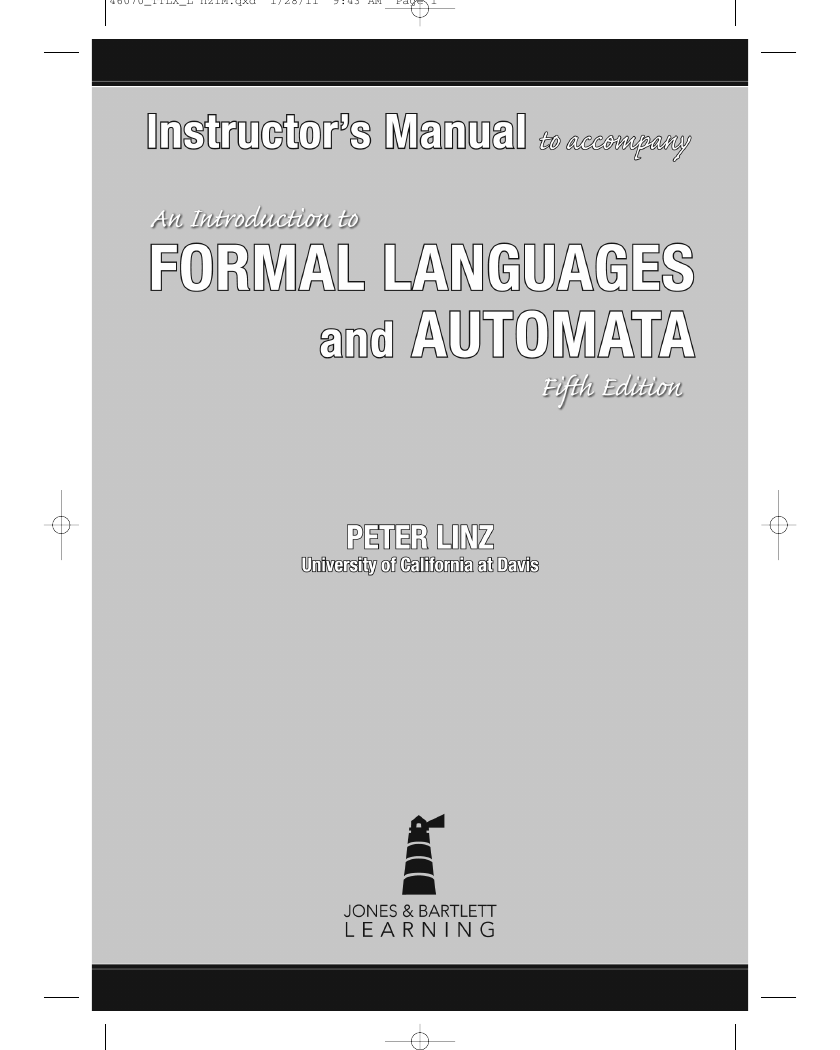
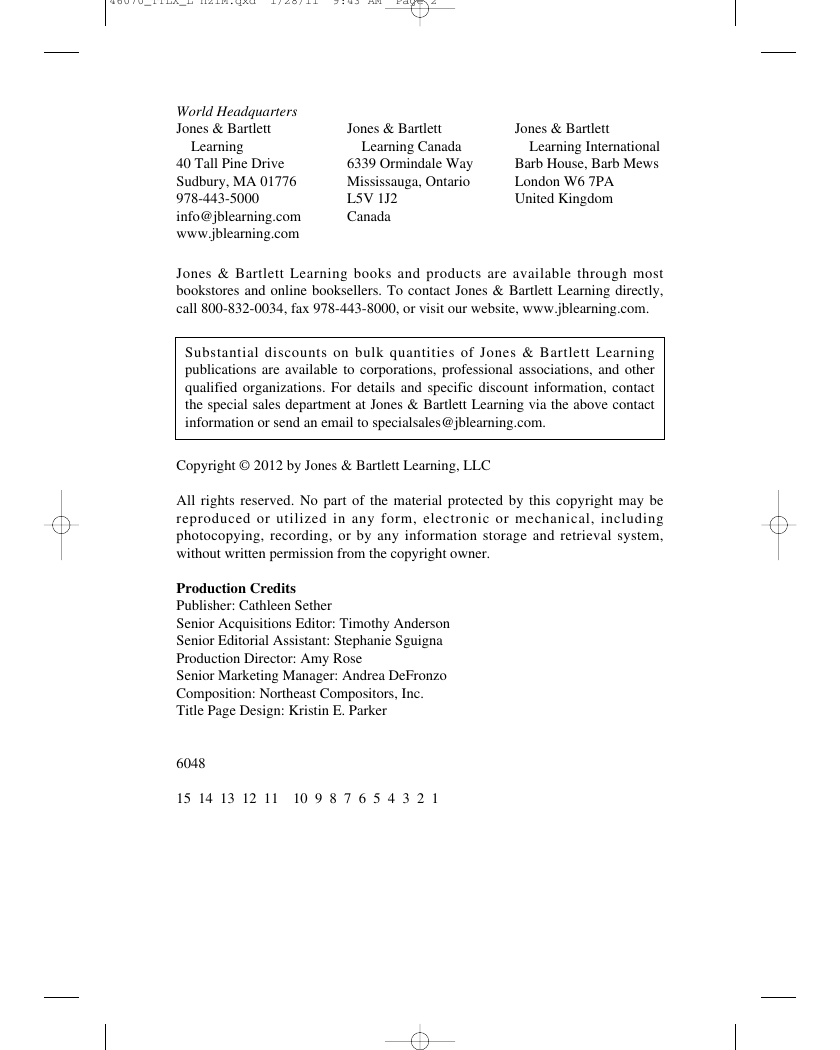
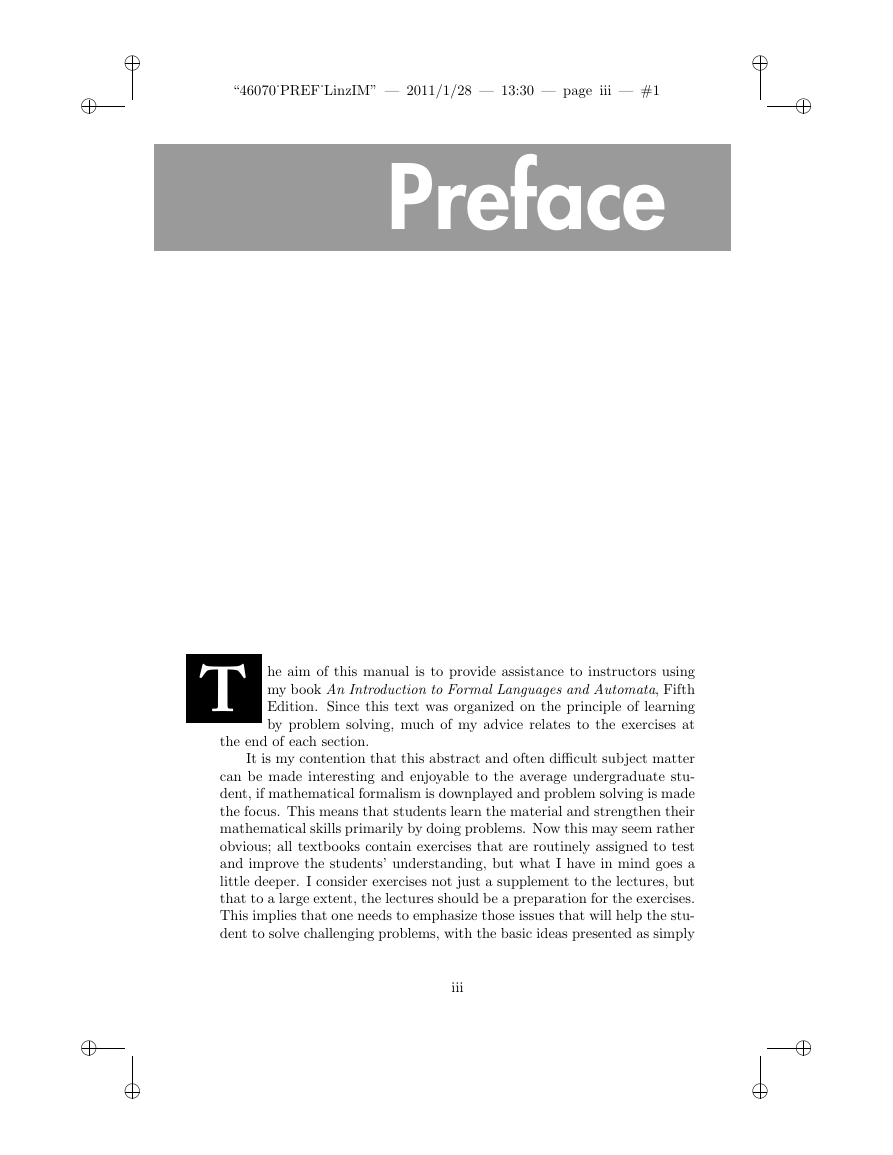
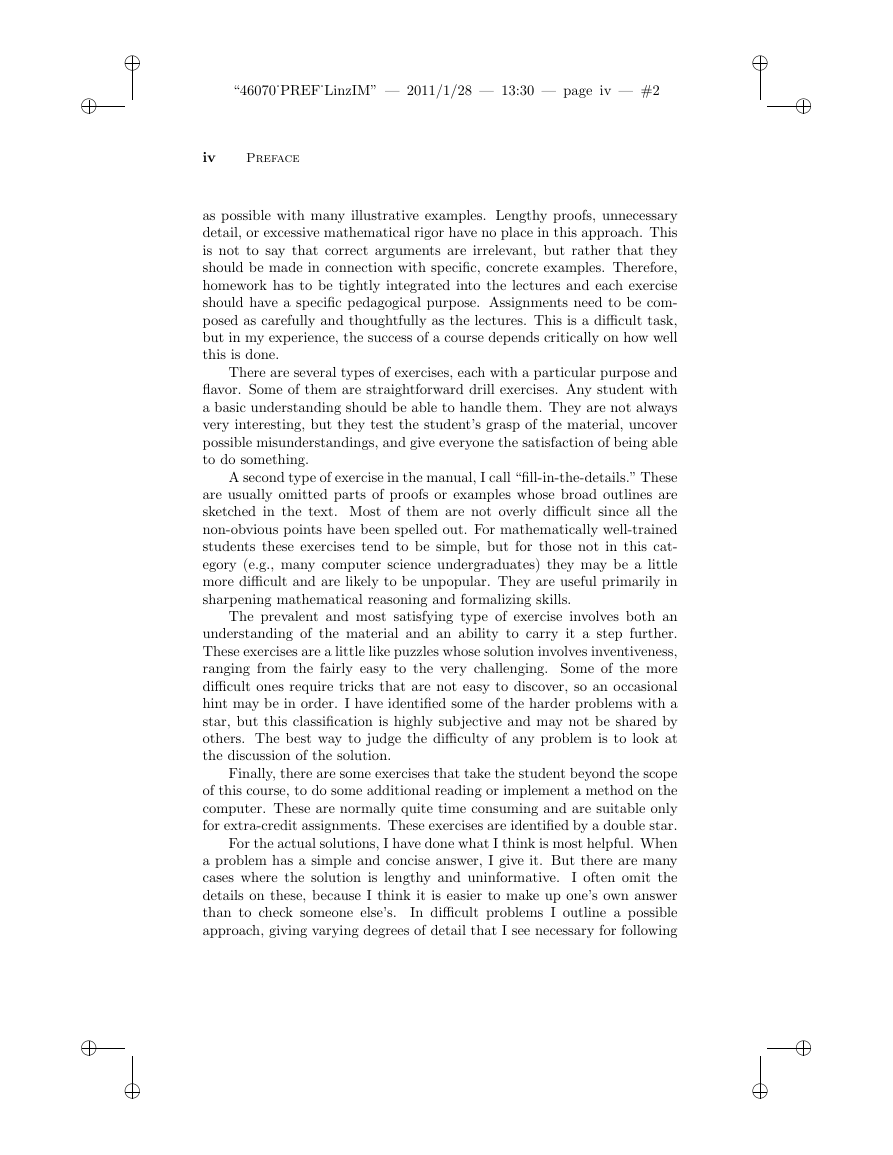
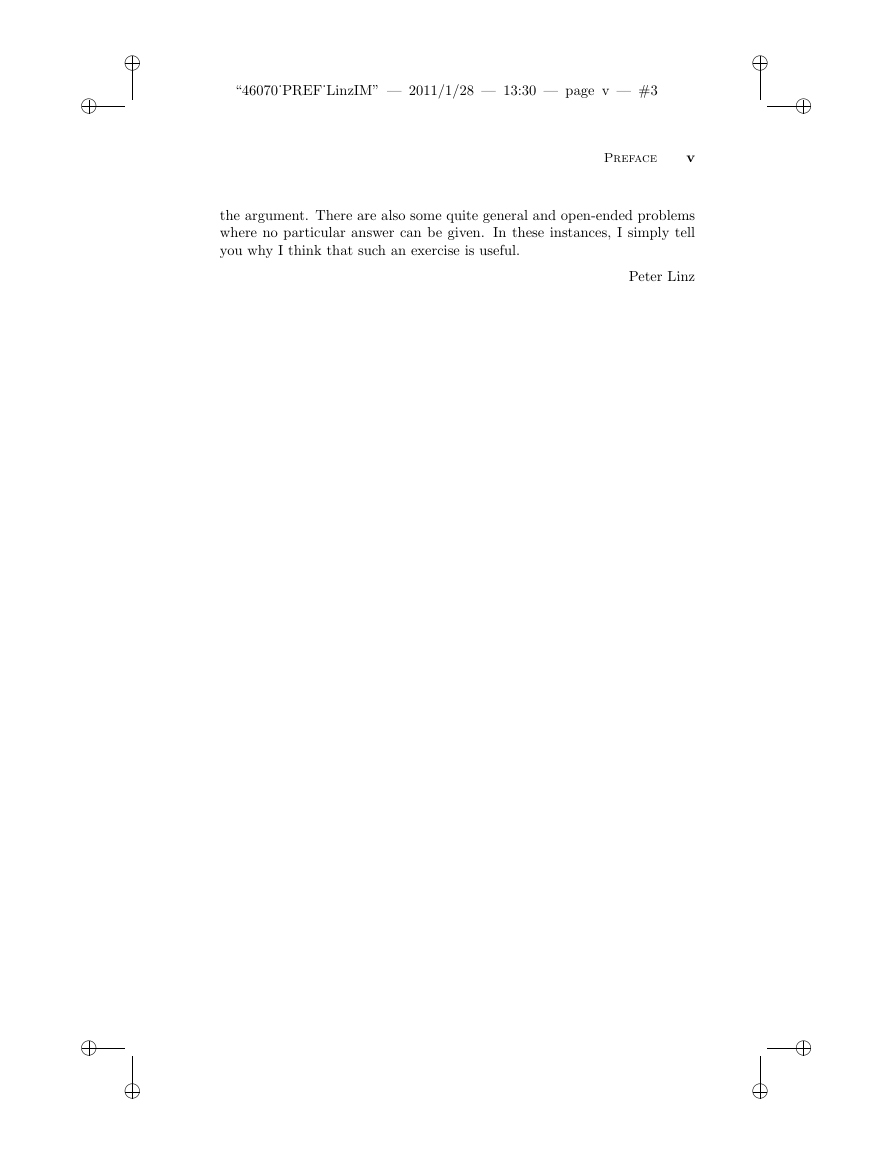
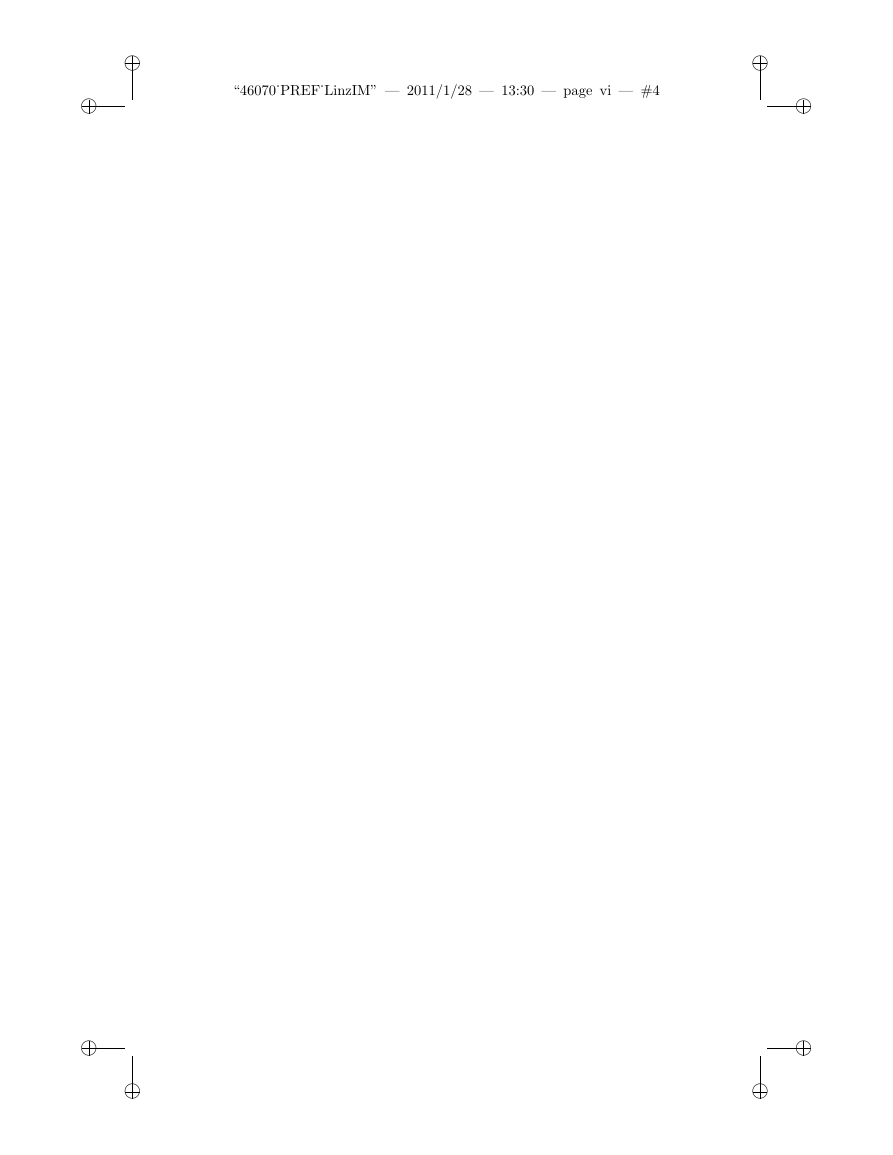
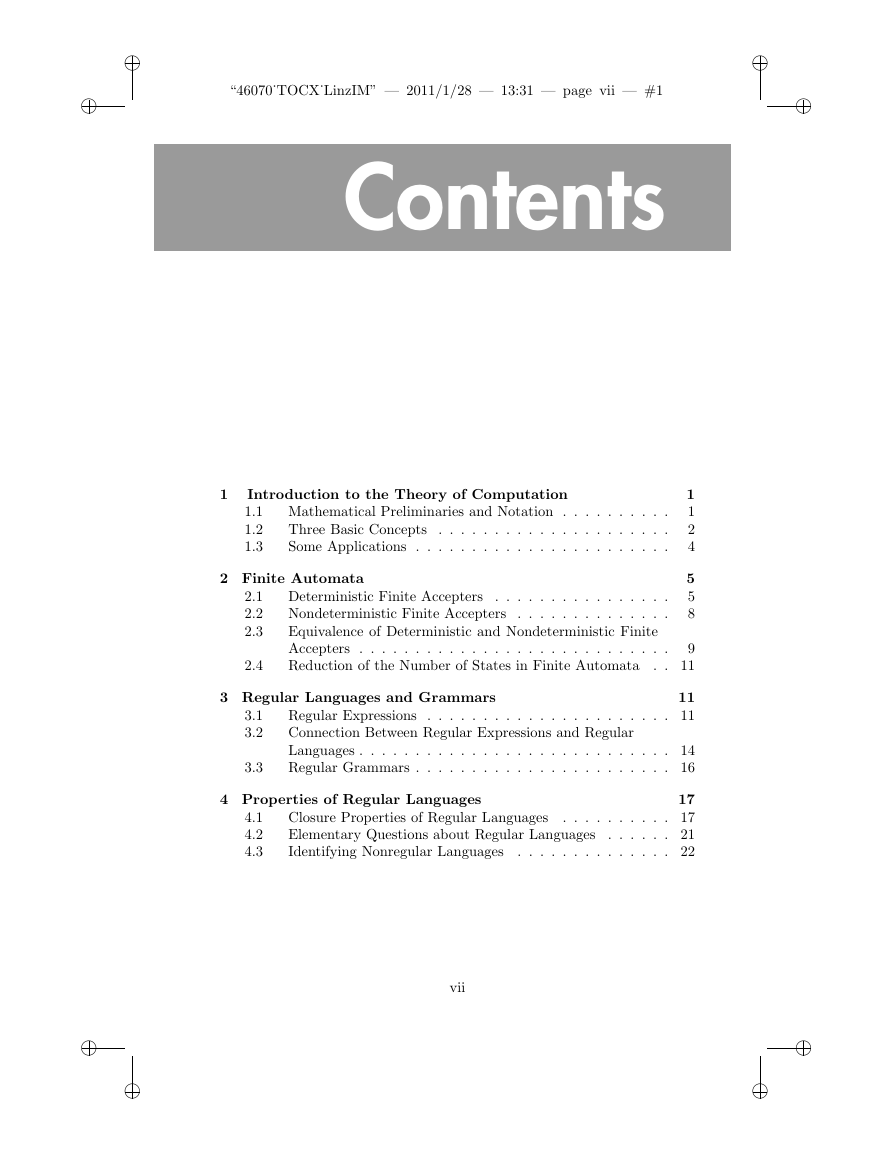
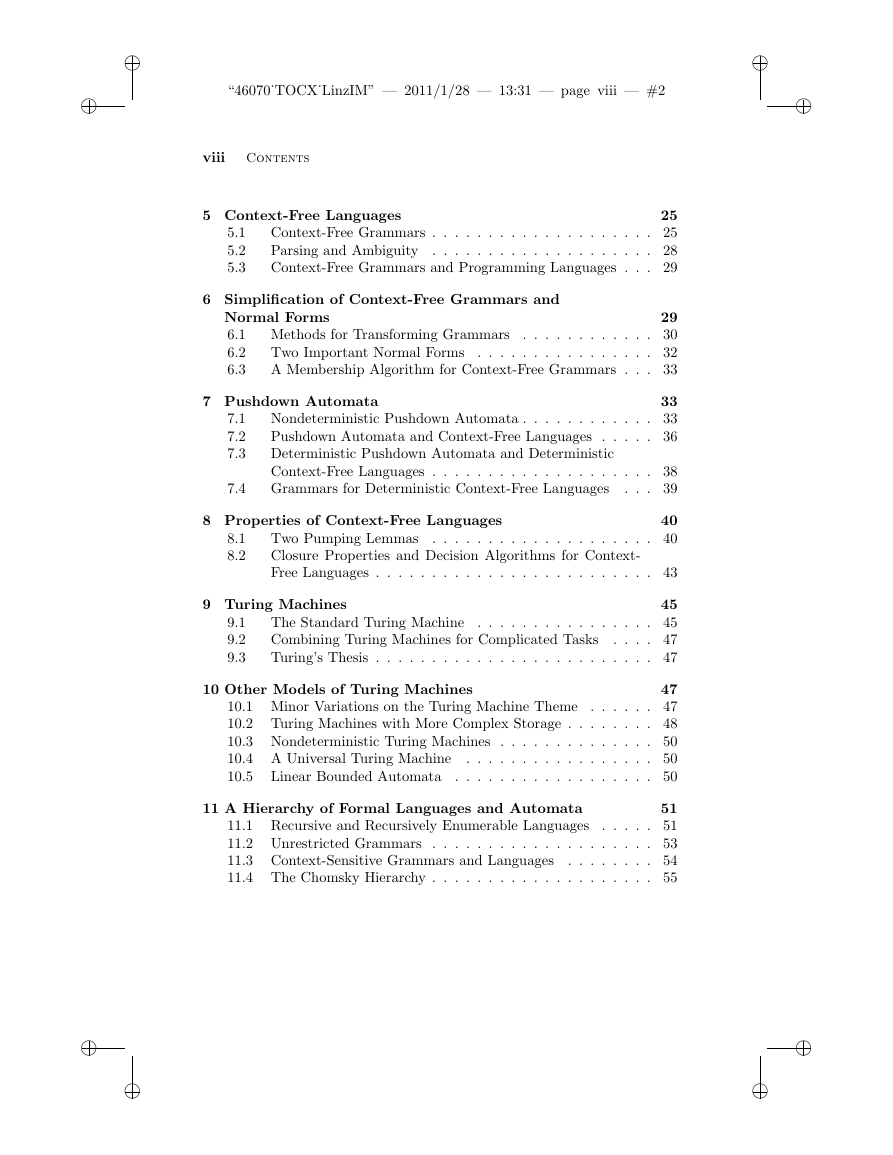








 2023年江西萍乡中考道德与法治真题及答案.doc
2023年江西萍乡中考道德与法治真题及答案.doc 2012年重庆南川中考生物真题及答案.doc
2012年重庆南川中考生物真题及答案.doc 2013年江西师范大学地理学综合及文艺理论基础考研真题.doc
2013年江西师范大学地理学综合及文艺理论基础考研真题.doc 2020年四川甘孜小升初语文真题及答案I卷.doc
2020年四川甘孜小升初语文真题及答案I卷.doc 2020年注册岩土工程师专业基础考试真题及答案.doc
2020年注册岩土工程师专业基础考试真题及答案.doc 2023-2024学年福建省厦门市九年级上学期数学月考试题及答案.doc
2023-2024学年福建省厦门市九年级上学期数学月考试题及答案.doc 2021-2022学年辽宁省沈阳市大东区九年级上学期语文期末试题及答案.doc
2021-2022学年辽宁省沈阳市大东区九年级上学期语文期末试题及答案.doc 2022-2023学年北京东城区初三第一学期物理期末试卷及答案.doc
2022-2023学年北京东城区初三第一学期物理期末试卷及答案.doc 2018上半年江西教师资格初中地理学科知识与教学能力真题及答案.doc
2018上半年江西教师资格初中地理学科知识与教学能力真题及答案.doc 2012年河北国家公务员申论考试真题及答案-省级.doc
2012年河北国家公务员申论考试真题及答案-省级.doc 2020-2021学年江苏省扬州市江都区邵樊片九年级上学期数学第一次质量检测试题及答案.doc
2020-2021学年江苏省扬州市江都区邵樊片九年级上学期数学第一次质量检测试题及答案.doc 2022下半年黑龙江教师资格证中学综合素质真题及答案.doc
2022下半年黑龙江教师资格证中学综合素质真题及答案.doc